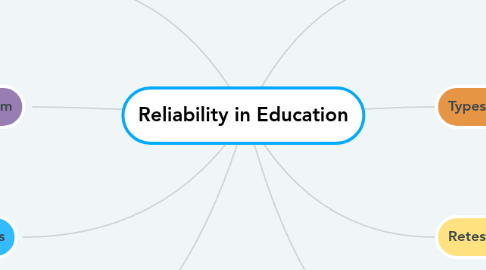Reliability in Education
by Marlee Duncan

1. Teacher Responsibilities
1.1. Design valid and reliable assessments.
1.2. Implement effective teaching strategies based on the data from assessments.
1.3. Continue to meet the needs of students based on the results.
2. Challenges in the Classroom
2.1. External factors that impact students' results on assessments.
2.2. Testing anxiety for students
3. Internal Consistency Methods
3.1. Split-half method
3.2. Kuder richardson method
3.3. Cronbach's alpha method
4. Interrater Consistency
4.1. This method is most common in qualitative assessments.
4.2. This method uses the percent agreement technique.
5. What is Reliability?
5.1. "Reliability is defined as the consistency of measurements when the testing procedure is repeated on a population of individuals of groups (AERA, APA, & NCME, 1999).
6. Types of Assessments
6.1. Quantitative assessments
6.2. Qualitative assessments
7. Retesting Students
7.1. The overall goal of retesting students after a period of time is to gain consistency.
7.2. Reliability coefficients and coefficient of stability.
8. Methods Based on Equivalence
8.1. Alternate-forms method
8.2. Equivalent- forms method
8.3. *These methods are often used in standardized testing.


